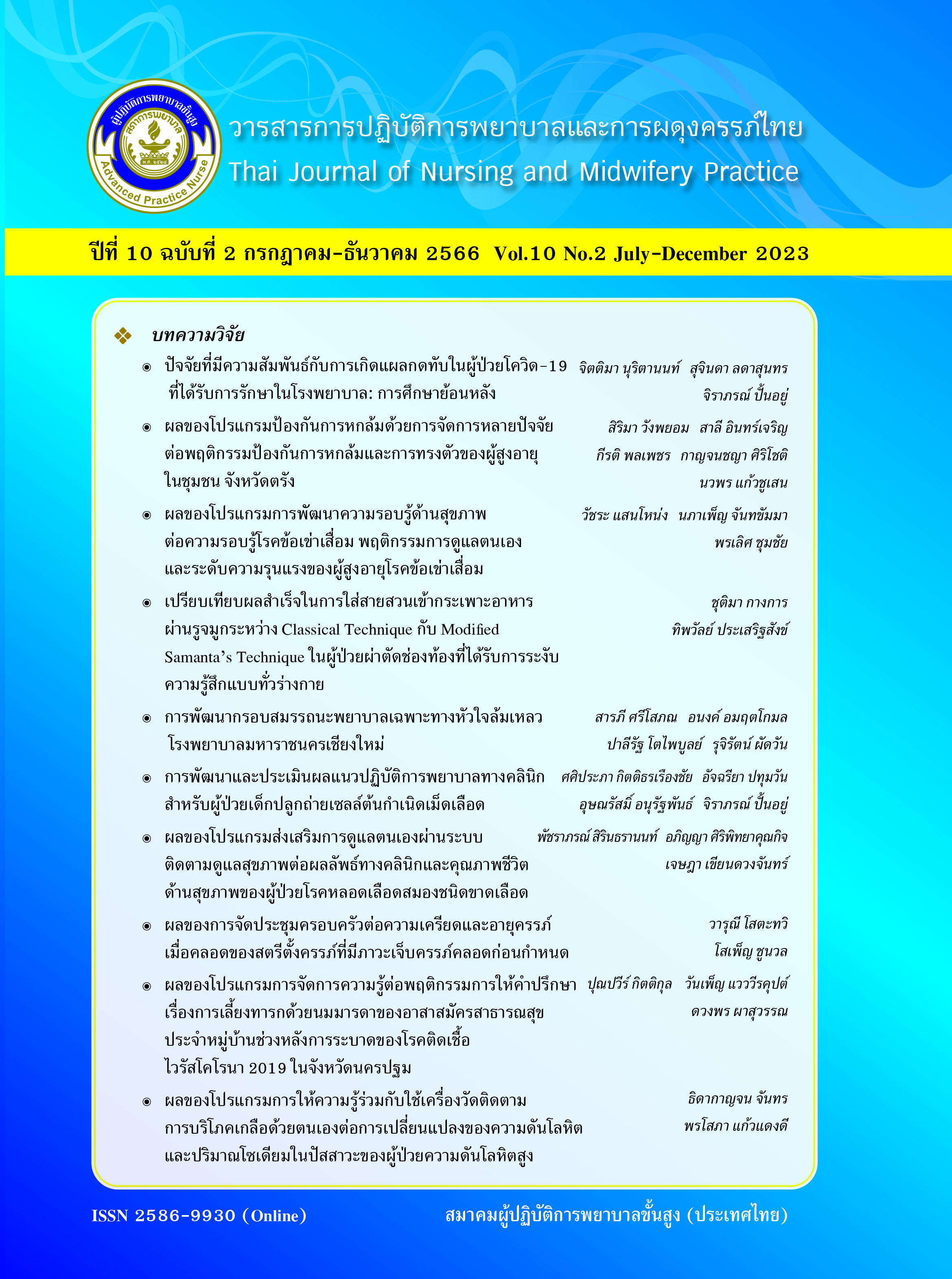Factors Associated with Pressure Injury in Hospitalized COVID-19 Patients: A Retrospective Study
Main Article Content
Abstract
Abstract: Coronavirus disease 2019 (COVID-19) is an emerging disease occurring worldwide and spreading widely. It affects physical and mental health, leading to various complications, especially pressure injury. This retrospective study aimed to identify factors associated with pressure injury among COVID-19 patients admitted to a university hospital. The sample consisted of 310 COVID-19 patients who were hospitalized during August 1–31, 2021, and met inclusion criteria. Data were collected retrospectively from medical records via electronic medical records. The data were analyzed using descriptive statistics and logistic regression analysis. The results revealed that the most important factors associated with pressure injury in COVID-19 patients were having peripheral venous catheter insertion. The patients with peripheral venous catheter insertion were 17.68 times more likely to have pressure injury compared with not having peripheral venous catheter insertion (OR = 17.68, p = .018). Secondly, patients receiving endotracheal intubation were 8.87 times more likely to have a pressure injury compared to patients who were spontaneously breathing (OR = 8.87, p = .000). In addition, each increase of 1 day in hospital length of stay increased 1.05 times for the risk of developing pressure injury (OR = 1.05, p= .002). The results of this study can be used as basic information for planning and developing guidelines for the prevention and care of hospitalized COVID-19 patients at risk of pressure injury in order to increase the quality of effective nursing care.
Downloads
Article Details

This work is licensed under a Creative Commons Attribution-NonCommercial-NoDerivatives 4.0 International License.
References
Garnier-Crussard A, Forestier E, Gilbert T, Krolak-Salmon P. Novel Coronavirus (COVID-19) Epidemic: What Are the Risks for Older Patients?. J Am Geriatr Soc. 2020; 68(5): 939-40. doi: https://doi.org/10.1111/jgs.16407
World Health Organization (WHO). Coronavirus disease 2019 (COVID-19) data as reported by the Thai Ministry of Public Health [Internet]. 2020 [cited 2022 February 6]. Available from: https://www.who.int/docs/default-source/searo/thailand/2020-05-05-tha-sitrep-72- covid19.pdf?sfvrsn=7708b03c_2
Infectious disease medicine and epidemiology. Basic knowledge of COVID-19. Faculty of Medicine Ramathibodi Hospital Mahidol University [Internet]. 2020 [cited 2022 January 10]. Available from: http://phoubon.in.th/covid20%rama.pdf. (in Thai)
Bellosta R, Luzzani L, Natalini G, Pegorer MA, Attisani L, Cossu LG, et al. Acute limb ischemia inpatients with COVID-19 pneumonia. J Vasc Surg. 2020. Dec; 72(6):1864–72. doi: https://doi.org/10.1016/j.jvs.2020.04.483.
Cuker A, Peyvandi F. Coronavirus disease 2019 (COVID-19): Hypercoagulability [internet]. 2020 [cited 2022 February 10]. Available from: https://www.uptodate.com/contents/covid-19-hypercoagulability.
Colling ME, Kanthi Y. COVID-19-associated coagulopathy: An exploration of mechanisms. Vasc Med. 2020; 25(5):471–8. doi: https://doi.org/10.1177/1358863X20932640
Miesbach W, Makris M. COVID-19: Coagulopathy, risk of thrombosis, and the rationale for anticoagulation. Clin Appl Thromb Hemost. 2020; 26: 1076029620938149. doi: https://doi.org/10.1177/1076029620938149
Huang C, Wang Y, Li X, Ren L, Zhao J, Hu Y, et al. Clinical features of patients infected with 2019 novel coronavirus in Wuhan, China. Lancet. 2020;395(10223):497-506.
Baron M, Santos M, Werle T, Scherer G, Santos M, Ley Domínguez L, et al. Does COVID-19 infection increase the risk of pressure injury in critically ill patients?: A narrative review. Medicine. 2022; 101(11):e29058. doi:10.1097/MD.0000000000029058
Amini M, Mansouri F, Vafaee K, Janbakhsh A, Mahdavikian S, Moradi Y, et al. Factors affecting the incidence and prevalence of pressure ulcers in COVID-19 patients admitted with a Braden scale below 14 in the intensive care unit: Retrospective cohort study. Int Wound J. 2022;19(8):2039-54. doi: 10.1111/iwj.13804
Lavin W, Yooyadmak P, Panasittivana V, Klinungkab K. Pressure injury among COVID-19 patients in critical care division: case study during the first wave of COVID-19 pandemic. Dis Control J. 2022;48(4): 750-7. (in Thai)
Pressure Injury Prevention Subcommittee of Faculty of Medicine Ramathibodi Hospital Mahidol University. Statistics on the incidence of pressure injury [excel program]: Computer file; 2021. (in Thai)
Moore Z, Patton D, Avsar P, et al. Prevention of pressure ulcers among individuals cared for in the prone position: lessons for the COVID-19 emergency. J Wound Care. 2020;29(6):312-20. doi:10.12968/jowc.2020.29.6.312
Perrillat A, Foletti JM, Lacagne AS, Guyot L, Graillon N. Facial pressure ulcers in COVID-19 patients undergoing prone positioning: How to prevent an underestimated epidemic?. J Stomatol Oral Maxillofac Surg. 2020;121(4):442-4. doi:10.1016/j.jormas.2020.06.008
European Pressure Ulcer Advisory Panel (EPUAP), National Pressure Injury Advisory Panel (NPIAP), Pan Pacific Pressure Injury Alliance (PPPIA). Prevention and treatment of pressure ulcers/injuries: Clinical practice guideline, the international guideline 2019 [internet]. 2019 [cited 2023 May 12]. Available from: https://www.biosanas.com.br/uploads/outros/artigos_cientificos/ 127/956e0
d7140b9bb3cdf116d13b.pdf.
Mervis JS, Phillips TJ. Pressure ulcers: Pathophysiology, epidemiology, risk factors, and presentation. J Am Acad Dermatol. 2019;81(4):881-90. doi: 10.1016/j.jaad.2018.12.069.
Agrawal K, Chauhan N. Pressure ulcers: Back to the basics. Indian J Plast Surg. 2012; 45(2):244-54. doi:10.4103/0970-0358.101287
Charlson ME, Ales PPL, MacKenzie CR. A new method of classifying prognostic comorbidity in longitudinal studies: Development and validation. J. Chronic Dis. 1987; 40(5):373-83. doi: 10.1016/0021-9681(87)90171-8.
Suttipong C, Sinthu S. Factors predicting the incidence of pressure ulcers in the elderly with stroke without diabetes. Nurs Sci J Thail. 2012; 29 (2):113-23. (in Thai)
Bootthumpan O, Lavin W. Factors associated with pressure ulcer incidence in cardiogenic patients at a university hospital: A retrospective, paired study. Mahidol R2R e-Journal. 2020; 7(1):140-8. (in Thai)
Sianes-Gallén M, Pujol-García AM, Rus García M, Partera Luque C, López Postigo M, Call Mañosa S, et al. Pressure injuries during the SARS-CoV-2 pandemic: A retrospective, case-control study. J Tissue Viability. 2021; 30(4):478-83. doi: 10.1016/j.jtv.2021.07.011.
Serra R, Caroleo S, Buffone G, Lugarà M, Molinari V, Tropea F, et al. Low serum albumin level as an independent risk factor for the onset of pressure ulcers in intensive care unit patients. Int Wound J. 2014; 11(5):550-3. doi: 10.1111/iwj.12004.
Yu J-N, Wu B-B, Feng L-P, Chen H-L. COVID-19 related pressure injuries in patients and personnel: A systematic review. J Tissue Viability. 2021; 30(3):283-90. doi: 10.1016/j.jtv.2021.04.002.
Martel T, Orgill DP. Medical device-related pressure injuries during the COVID-19 pandemic. J Wound Ostomy Continence Nurs. 2020; 47(5):430-4. doi: 10.1097/WON.0000000000000689.
Jaul E, Barron J, Rosenzweig JP, Menczel J. An overview of co-morbidities and the development of pressure ulcers among older adults. BMC Geriatr. 2018; 18(1): 305. doi: https://doi.org/10.1186/s12877-018-0997-7


